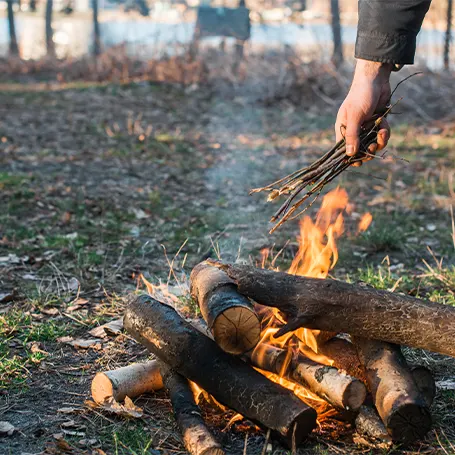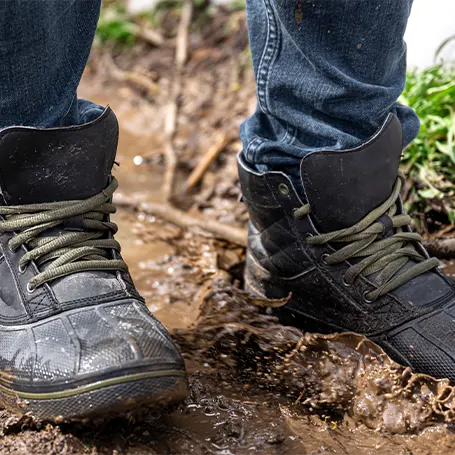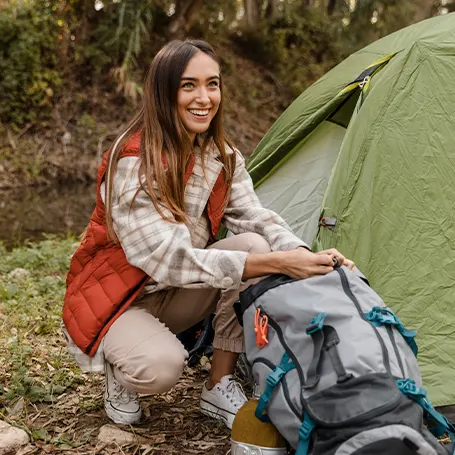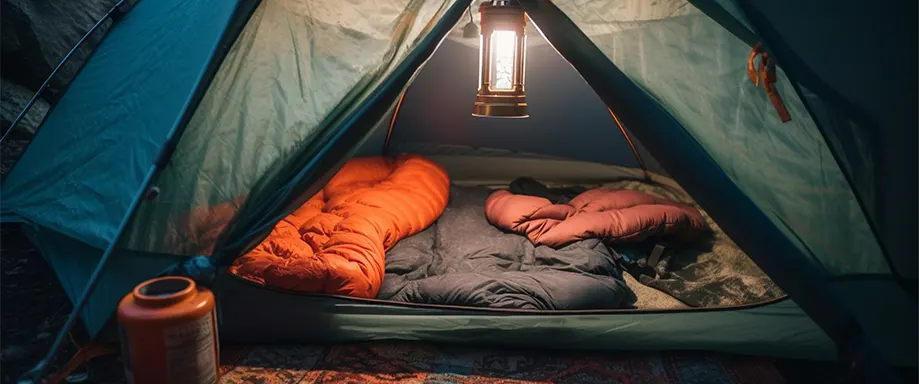How temperature affects sleep

First off, let's talk about how the temperature affects your body and your sleep. We point this out because it's not as straightforward as you might think. For example, did you know that sleeping in a cold room can make it easier to fall asleep? This is because our biological clock, or circadian rhythm, takes the drop in temperature as a cue that it's night and therefore time to sleep.
So, the temperature can definitely affect sleep in a positive way! However, our body temperature shouldn't really go below 35 degrees if we want to get proper rest. This is why you don't see people sleeping like logs while sleeping on a pile of snow.
Therefore, the two main takeaways are – being a bit cold is alright, however, if it gets too cold, you're unlikely to get any sleep. So, let's talk about sleeping outside in general and then we'll move on to some cold weather camping tips that can make the cold a bit less scary.
Sleeping outside with no gear

Whether you drank a bit too much and fell asleep on a lawn chair or you just wanted some fresh air, you can sleep outside even without a sleeping bag or tent. However, quite a few criteria need to be met.
As far as the temperature goes, we wouldn't recommend sleeping outside without gear unless it's at least 15 degrees Celsius. This is because lower temperatures will quickly sap your body heat and leave you shivering.
On a similar note, it's important to take the environment into account. For example, even if it's 20-degree weather, cold air can quickly put a chill into your bones. And if you don't have a sleeping bag or a sleeping pad, it will be a lot more difficult to stay warm. Not to mention that sudden rainfall can turn spring camping into winter camping in a second!
In other words, try to avoid sleeping outside unless you have the appropriate gear. If it's summer, there's not much wind, and there's no chance of rain, you can technically do it. However, cold nights can come in a flash and it's always better to play it safe. At the very least, have an all-season duvet handy!
Sleeping outside with gear

Realistically, most of you are only going to be sleeping outside while on a camping trip. So, here's what we're going to do. We're going to go down the list, season by season, and talk about all the potential gear you could need in order to stay warm and safe.
Of course, things such as a good sleeping bag are always going to be recommended. However, depending on the average temperature and whether there's rain, the exact type you need can differ.
But this is just a very generalised list. Depending on where you live, how easily you get cold, where you set up camp, and other factors, different gear could be required. So, know that this isn't the end-all-be-all guide on sleeping outside!
Spring
In a lot of ways, spring is the best time to be sleeping outside. This is because, while it's not the warmest season, it's statistically the driest. So, while you should still have a backup plan, rain doesn't pose as much of a danger as during autumn. Nevertheless, you still need some gear.
A decently warm sleeping bag
In 2022, the average daily temperature ranged from about 7 to 13 degrees. And since the days start getting longer during the spring, staying warm is generally a lot easier. However, you still need some gear to get through the cold night.
Generally, we a three-season sleeping bag should suit you just fine in the spring. Just check that the temperature comfort rating is at least 5 degrees Celsius and you should be relatively comfortable.
A tent
Even if the night isn't particularly cold, having a tent is a must in our books. This is because the cold ground can make your temperature drop pretty quickly. And a sharp wind can make 10-degree weather feel like you're at 0 degrees.
However, unlike during most of the year, the tent itself usually doesn't have to be too specific. Being waterproof and sturdy is always a good thing but it's less essential during the spring than let's say winter or autumn.
Summer
During the summer, sleeping outside is both incredibly easy and somewhat annoying. On the one hand, you can expect high temperatures and short nights. And with an average temperature of about 15-18, you generally don't have to worry too much. On the other hand, you can expect every insect known to man to suddenly be inside your sleeping bag. So, here's what you'll need.
A breathable sleeping bag
While you spend the entire day during the summer trying to stay cool, you should still have a sleeping bag during the night. With that being said, finding a breathable model is still more than welcome.
So, while a three-season sleeping bag will get the job done, a summer sleeping bag is even better. In other words, a rectangular sleeping bag that isn't flush with your skin but rather allows for extra ventilation.
A bug net
Whether you're sleeping in a tent or a hammock, make sure that you have some bug net around you. After all, while sleeping pads might protect you from ants, mosquitos and flies will ruin your entire night. Plus, a big net might intimidate other wildlife from coming closer and giving you quite the scare.
Autumn
If you want to sleep outside during autumn, your main concern should be rain. Let's be realistic, the UK is notorious for having constant rain but autumn is especially troublesome in this regard.
However, the temperature by itself isn't too much of an issue – with a daily average of about 9 to 14 degrees. So, here are some of the steps that you should take in order to avoid getting soaked.
A sleeping pad
Rain is bad enough on its own but things get much worse if you're also covered in mud. So, having both a sleeping bag and a sleeping pad could be quite the lifesaver. Alternatively, you could even get a hammock in order to be completely off the ground. However, make sure you have some sort of shelter so that a heavy downpour doesn't ruin everything.
Waterproof gear
Both your tent and your sleeping bag need to be waterproof so that you can stay warm and dry. If you're expecting an especially heavy downpour, set up camp under thick foliage or some other kind of shelter. Even the warmest sleeping bags are useless when completely wet, so, give it some thought!
And while higher-end sleeping bags don't have this problem, know that a down sleeping bag can be severely damaged if wet. So, if that's all you have, make sure to get a waterproof sleeping bag liner and seek shelter.
Winter
Of course, when it comes to the dangers of sleeping outside, winter camping trips are at the very top. With an average temperature of just 1 to 4 degrees, snow, and winds that can chill you to the bone, winter trips require the most planning. After all, you typically can't find colder weather than what you experience during winter nights.
Specialised sleeping bags
So far, 3-season sleeping bags have been adequate. However, during winter, getting a winter sleeping bag is usually necessary. That means having a sleeping bag rated at a comfort level of around zero degrees and an extreme level of negative 10-15.
Of course, this depends on where in the UK you live, whether it's early or late winter, whether there's snow and so on. However, it's generally better to be a bit hot than to freeze. So, play it safe.
Extra heating
During winter nights, you might need heating sources aside from just your sleeping bag. This could be in the form of a hot water bottle, a campfire, or an electric heater. However, make sure to read all the safety labels for the latter two as you don't want to set your tent on fire by accident!
Other useful heating sources could be a winter jacket, the thickest socks you can find, scarves or anything else you can use to cover your face, etc. Remember, your body temperature needs to be around 35 degrees in order to easily drift off to sleep. So, the more options you have, the better!
Conclusion
In conclusion, it's difficult to say what temperature is too cold for outdoor sleep. That's because aside from the air temperature, we have to account for your gear, whether there's wind, rain, snow, your preferences, and so much more.
But generally speaking, camping in cold weather, like during winter, or when it's raining, like autumn, should require the most forethought. Summer and spring are a bit more forgiving but you still shouldn't underestimate how quickly the temperature can drop during the night.
Spread the word
Recommended reading:













There are no comments yet
"*" indicates required fields